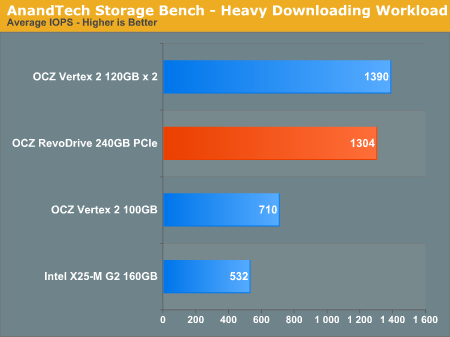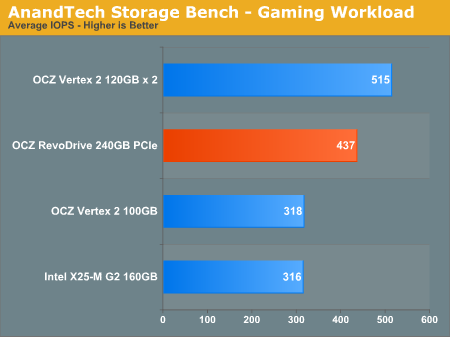OCZ's RevoDrive Preview: An Affordable PCIe SSD
by Anand Lal Shimpi on June 25, 2010 2:15 AM ESTAnandTech Storage Bench
The first in our benchmark suite is a light usage case. The Windows 7 system is loaded with Firefox, Office 2007 and Adobe Reader among other applications. With Firefox we browse web pages like Facebook, AnandTech, Digg and other sites. Outlook is also running and we use it to check emails, create and send a message with a PDF attachment. Adobe Reader is used to view some PDFs. Excel 2007 is used to create a spreadsheet, graphs and save the document. The same goes for Word 2007. We open and step through a presentation in PowerPoint 2007 received as an email attachment before saving it to the desktop. Finally we watch a bit of a Firefly episode in Windows Media Player 11.
There’s some level of multitasking going on here but it’s not unreasonable by any means. Generally the application tasks proceed linearly, with the exception of things like web browsing which may happen in between one of the other tasks.
The recording is played back on all of our drives here today. Remember that we’re isolating disk performance, all we’re doing is playing back every single disk access that happened in that ~5 minute period of usage. The light workload is composed of 37,501 reads and 20,268 writes. Over 30% of the IOs are 4KB, 11% are 16KB, 22% are 32KB and approximately 13% are 64KB in size. Less than 30% of the operations are absolutely sequential in nature. Average queue depth is 6.09 IOs.
The performance results are reported in average I/O Operations per Second (IOPS):

The OCZ RevoDrive does very well in our light usage case, but it does echo what we saw in the PCMark results. The performance benefit here is 27% however that’s purely I/O. Taken in the context of the real world with CPU and other bottlenecks you’re probably looking at a 7 - 15% performance advantage. Thankfully the RevoDrive doesn’t come with a high premium, making the added performance very cost effective.
If there’s a light usage case there’s bound to be a heavy one. In this test we have Microsoft Security Essentials running in the background with real time virus scanning enabled. We also perform a quick scan in the middle of the test. Firefox, Outlook, Excel, Word and Powerpoint are all used the same as they were in the light test. We add Photoshop CS4 to the mix, opening a bunch of 12MP images, editing them, then saving them as highly compressed JPGs for web publishing. Windows 7’s picture viewer is used to view a bunch of pictures on the hard drive. We use 7-zip to create and extract .7z archives. Downloading is also prominently featured in our heavy test; we download large files from the Internet during portions of the benchmark, as well as use uTorrent to grab a couple of torrents. Some of the applications in use are installed during the benchmark, Windows updates are also installed. Towards the end of the test we launch World of Warcraft, play for a few minutes, then delete the folder. This test also takes into account all of the disk accesses that happen while the OS is booting.
The benchmark is 22 minutes long and it consists of 128,895 read operations and 72,411 write operations. Roughly 44% of all IOs were sequential. Approximately 30% of all accesses were 4KB in size, 12% were 16KB in size, 14% were 32KB and 20% were 64KB. Average queue depth was 3.59.

Our heavy test shows the RevoDrive nearly doubles the performance of a single OCZ Vertex 2.
The gaming workload is made up of 75,206 read operations and only 4,592 write operations. Only 20% of the accesses are 4KB in size, nearly 40% are 64KB and 20% are 32KB. A whopping 69% of the IOs are sequential, meaning this is predominantly a sequential read benchmark. The average queue depth is 7.76 IOs.

Our gaming workload also improves a bit as well. This thing is quick. A pair of Vertex 2s in RAID are still faster thanks to Intel's controller.










62 Comments
View All Comments
MrBrownSound - Wednesday, August 25, 2010 - link
Should I be worried putting my OS on this drive? Also I have two steamy hot graphics cards, will a fan be needed?diqster - Sunday, September 26, 2010 - link
While you claim these PCIe SSDs are aimed at the enterprise market (they are), you didn't hit very many enterprise benchmarks or concerns. I'd like to see these things reviewed in any PCIe SSD review:1) Form factor. Can they fit in a half height or half length PCI slot? Putting this in tandem with spinning metal HD's in a 1U server would be ideal. Flashcache setups come to mind. The previous OCZ offerings failed miserably in this department as they're as long as some GPU cards.
2) You mentioned RAID controller, but no mention of a BBWC. A BBWC (like on the old OCZ R-Drive) would drastically speed up random writes. Enterprises are looking at flash to solve 2 problems, either random reads or random writes.
3) Enterprises don't care much about sequential I/O here. Very few things in a datacenter environment would use sequential I/O. For things like databases or key value stores, it's all random. Sure, video editing is sequential but it's neither enterprise (in most senses) nor is it very popular (number of DB's installed worldwide dwarfs number of video editors).
4) Addressing write lifetimes. Consumers can swap and replace these cards one at a time if they fail every 2 years. Doing that over installations of hundreds or thousands of these cards is rather hard. People want to know if they'll last. Again, a BBWC would help address some of these issues -- only letting the last write of 100 writes to a block go through.
If you want to be taken seriously, start reviewing stuff in an enterprise manner. As of now, these are consumer-based reviews of enterprise gear.